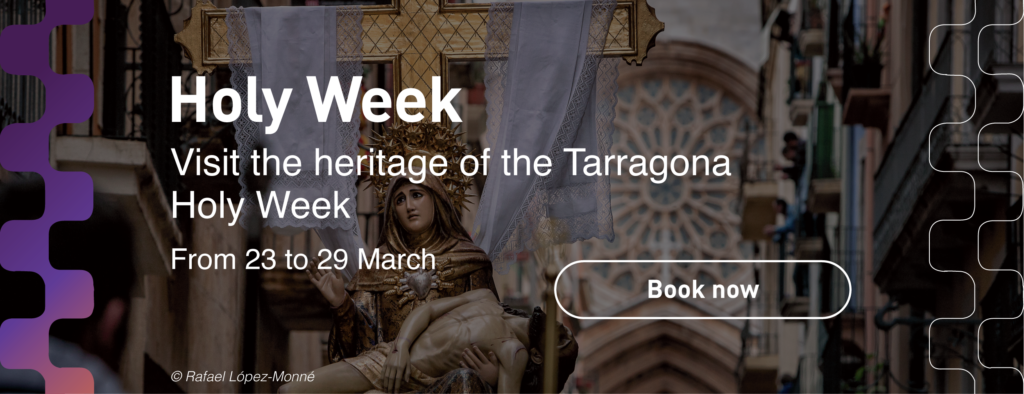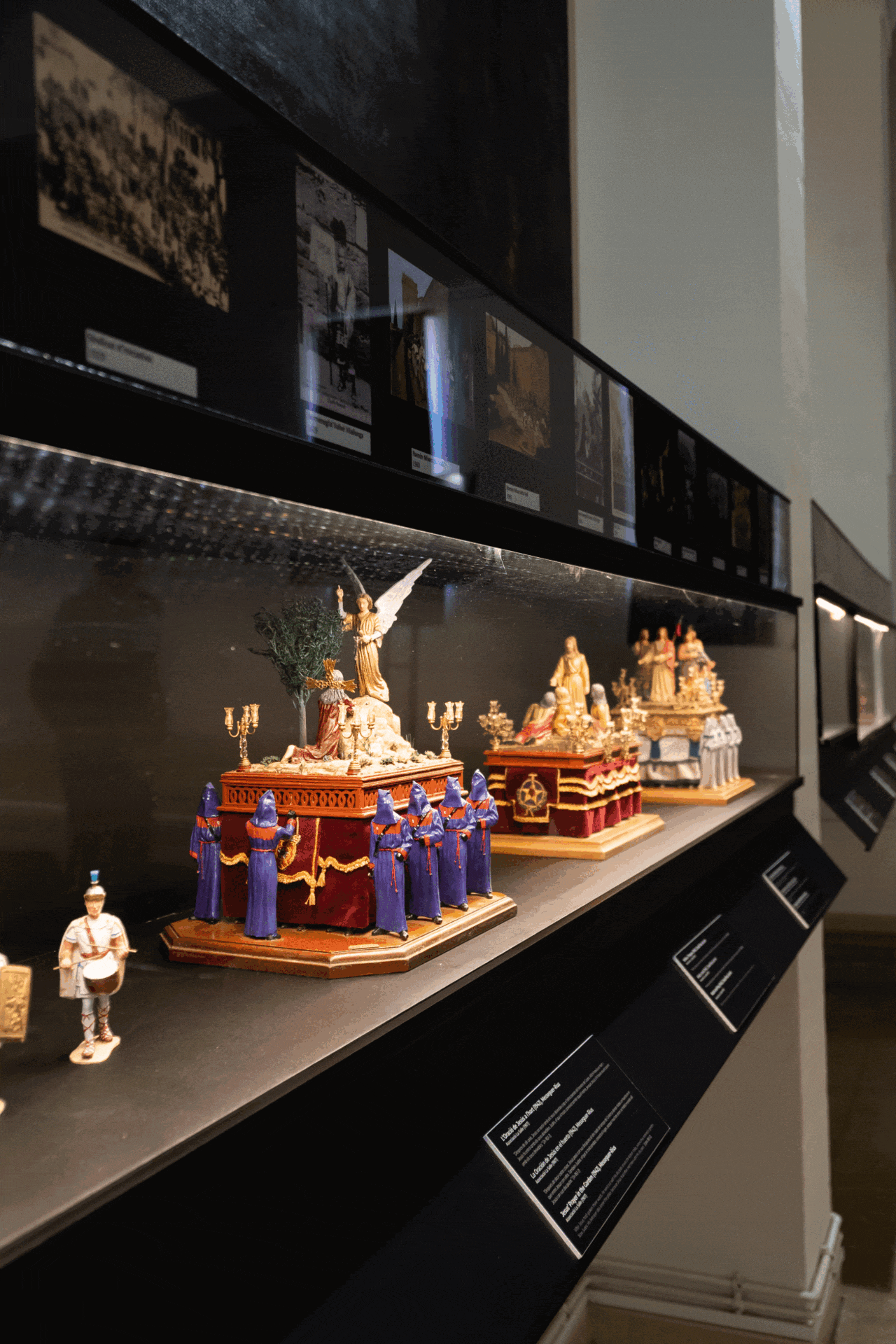Get to know in depth the Easter Week in Tarragona, declared “Local Festival of Tourist Interest” by the Generalitat de Catalunya, through the 6 sites that explain its history throughout the year. An essential visit in Tarragona.
TARRAGONA BIBLICAL MUSEUM
The Easter Week area of the Tarragona Biblical Museum is considered the Km0 of the Easter Week route in Tarragona. This space consists of an audiovisual that explains, through the experiences of a costalero (person who carries the processional pasos) the biblical, cultural, and social meaning of this popular religious event.
A series of archaeological pieces and reproductions provide the biblical and theological account of the “first Easter Week in history“. A collection of photographs, posters and historic postcards and a collection of miniatures of the pasos (platform on which religious images are carried in processions) during the Easter Week in Tarragona provide a cultural and artistic account of this religious event in the Archdiocese and especially in the city of Tarragona. Finally, the space has a polychrome chalk sculpture of Cardinal Francesc d’Assís Vidal i Barraquer. The work by the Tarragona artist Bruno Gallart Pardo makes a reference to the prelate’s meaning of Holy Week.
Visiting hours: Monday to Friday, from 9.00 am to 1.00 pm and from 3.00 pm to 6.00 pm.; Saturday from 9 a.m. to 2 p.m. (Sunday: closed). More information at museu.biblic.arqtgn.cat/horaris.
Admission fees:
- 4 €: adults.
- 3 €: under 18s, over 65s, accredited teachers, holders of the Accreditation Card for the Disabled.
- Free: Tarragona Pass, duly accredited unemployed people, ICOM members, Youth Card holders and children under 5 years old.
SANT LLORENÇ CHURCH
The Guild of Farmers preserves a rich heritage that includes the Sant Llorenç church, renovated by Josep Maria Jujol after the Civil War. Of particular note are the Gothic and Renaissance chapels with works by Josep M. Jujol and Josep M. Martisella, as well as the figures of the saints, reinterpreted by Josep Maria Jujol, and objects such as the chalice of the Catholic Monarchs. Inside there is a Gothic altarpiece and pieces by Josep M. Jujol, while the adjoining house houses the Espai Jujol. It is currently the canonical and social headquarters of the Guild of Farmers of Sant Llorenç and Sant Isidre and it houses two pasos inside: La Pietat and the Sant Sepulchre.
Visiting hours: open on public holidays and bookings by telephone: 637 71 69 69. From 23 to 30 March 2024: open to the public from 10.30 am to 1.30 pm and from 5.30 pm to 8.30 pm.
NATZARET CHURCH
The Santa Maria de Nazaret church, headquarters of the Royal and Venerable Congregation of the Immaculate Blood of Our Lord Jesus Christ since 1545, is a Cultural Asset of Local Interest, located in the Plaça del Rei. With an initially Romanesque floor plan from 1153 and a Baroque style temple from 1742, it stands out for its venerated images and as the starting point for the Holy Burial Procession every Good Friday, recognised as a Heritage Element of National Interest.
Inside it houses the figure of the Sant Crist de la Sang and three mysteries: The Solitude, The Flagellation and the Christ of the Penitents.
Visiting hours during Lent: Friday, from 6.00 pm to 7.00 pm; Saturday, from 11.00 am to 1.00 pm. From 23 to 30 March 2024: open to the public from 10.30 am to 1.30 pm and from 5.30 pm to 8.30 pm.
SANT MIQUEL DEL PLA
San Miquel del Pla, headquarters of the Jesus of Nazareth Royal Brotherhood, is a protected church dating from the 12th century, although its current construction dates from the 18th century. It preserves Romanesque and late Romanesque remains and has a documentary mention of the year 1154. Despite being small, it is notable for its decorated altars. It was modernised in 2008 after a desecration suffered in 1816.
It is currently the canonical headquarters of the Jesus of Nazareth Royal Brotherhood and houses its three pasos: Jesús de Nazaret, El Cirineu and Jesús Despullat de les seves vestidures.
Visiting hours: The church, which is not usually open to the public, is open from 23rd to 30th March 2024 from 10.30 am to 1.30 pm and from 5.30 pm to 8.30 pm.
SANT AGUSTÍ CHURCH
The San Agustí church, built in 1576 after the permission of the chapter of the Holy Cathedral, was completed in the following century despite financial difficulties. It is notable for its Baroque façade with a portal and bell towers and, inside, it houses a funerary crypt and a tombstone.
The Sant Agustí Church, the historic headquarters of ecclesiastical entities, stands out as the space with the most Holy Week content, exhibiting 10 pasos (Entrance of Jesus into Jerusalem, Holy Supper, The Prayer in the Garden, You Watch and Pray, Taking of Jesus, Holy Ecce Homo, Our Father Jesus of the Passion, Descent from the Cross, Return from Calvary and Holy Burial) of the 7 entities without their own church all year round. It is a crucial part of the Holy Week Spaces, together with the Biblical Museum of Tarragona.
Visiting hours: Monday to Saturday, from 6.30 p.m. to 7 p.m. and from 7.30 p.m. to 8 p.m.; Sunday, from 11 a.m. to 12.30 p.m. and from 1 p.m. to 1.30 p.m. From 23 to 30 March 2024: open to the public from 10.30 am to 1.30 pm and from 5.30 pm to 8.30 pm.
SANT NICOLAU DE BARI CHURCH
The Sant Nicolau de Bari church is linked to the school of the Dominican Sisters of Charity of the Presentation of the Blessed Virgin, known as “the French”, who settled in Catalonia at the end of the 19th century. After the school was abandoned following the civil war, a group of former pupils continued to maintain the worship of the church. It is a church owned by the Town Hall and ceded to the Brotherhood of the Christ of Good Love and Our Lady of Bitterness with Saint John the Evangelist. It is currently the headquarters of the organisation and houses its two pasos inside: Cristo del Buen Amor and Nuestra Señora de la Amargura con San Juan Evangelista.
Visiting hours: every Wednesday, from 5pm to 7pm, except August and public holidays. From 23 to 30 March 2024: open to the public from 10.30 am to 1.30 pm and from 5.30 pm to 8.30 pm.










